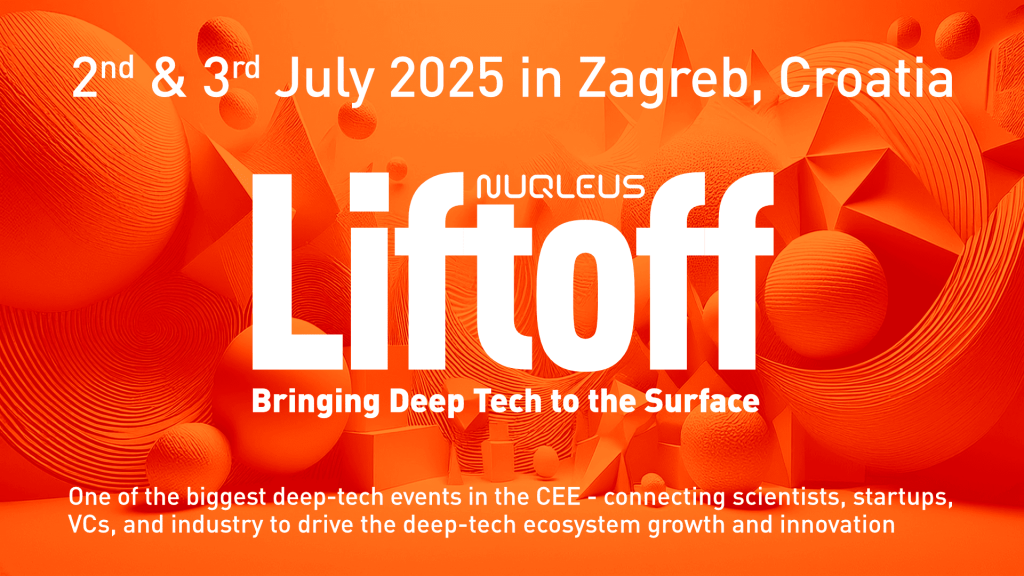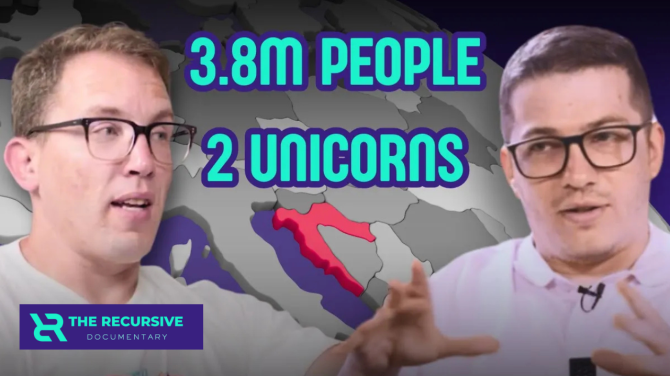As one of Central and Eastern Europe’s biggest deep tech events gears up to land in Zagreb this July, there’s no better time to reflect on what it actually takes to turn a scientific breakthrough into a company that matters.
Liftoff 2025, hosted by Nuqleus and held at SEECEL, is not just another tech conference. It’s a magnet for scientists, engineers, founders, and investors navigating the complex path from lab to market. With names like Flagship Pioneering, Goldman Sachs, the EIC, and more than 100 deep tech startups and scaleups from across the region, it promises serious conversations – not just about vision, but about execution.
Ahead of the event, we spoke to three people who know deep tech inside and out: Anna Stodolkiewicz, Head of the EIC Fund Investment Unit at the European Investment Bank; Alan Clayton, Human Capital Leader at global VC firm SOSV and creator of the “Wholebrain Startup” methodology for coaching scientist-founders; and Lana Dinić, Executive Director of Portfolio Strategy and Operations at Flagship Pioneering, where she helps launch and scale biotech companies developing transformative therapeutics.
Between them, they’ve built portfolios worth billions, shaped biotech revolutions, coached hundreds of scientists into CEOs, and seen more pitch decks than most of us see emails.
So we asked: What makes a deep tech startup truly investable? Where do founders go wrong? And what does real potential look like, beyond the hype?

What makes a deep tech team truly fundable?
Let’s start with the basics: what gets an investor to sit up, lean in, and take a second meeting?
According to Anna Stodolkiewicz, who leads the EIC Fund’s equity investment unit, a few things are non-negotiable when evaluating deep tech founders: self-awareness, moving fast, and a problem-solving mindset.
“A good level of self-awareness is essential,” she explains. “It helps founders identify their gaps and bring in the right people – not just technically, but commercially and as leaders.” Without it, teams risk becoming lopsided – strong in research but weak on execution. Just as important is a sense of urgency.
“In deep tech, development cycles can be lengthy and costly. However, your target market is usually global. This means that if you successfully bring your product to market, you can achieve scale and substantial upside. At the same time, your technology is competing with other deep tech teams and companies worldwide that are developing competing or alternative technologies. Reaching the market faster with an excellent product is often essential to securing a leading position.”
Finally, there’s the founder mindset. Whether the starting point is a lab discovery or a market need, founders must stay flexible and relentlessly focused. “You’ll face technological, financial, and market challenges all at once. A problem-solving mindset isn’t optional – it’s how you survive.”
Together, these traits aren’t just nice to have. “They’re what separate interesting research from an investable company,” Anna concludes.
Alan Clayton, who coaches deep tech founders around the world, puts it more bluntly:
“The founders need to:
1) be able to build their own tech rather than outsource anything significant;
2) pick someone who is an energetic and engaging storyteller;
3) have proof that they really have researched their user population;
4) have basic understanding of how the money flows through the business;
5) and then just a LOT of dedication to the cause.”
Can they really change the world?
Lana Dinić, whose work at Flagship Pioneering involves turning high-risk biotech ideas into transformative companies, knows how fragile team dynamics can be when pressure mounts.
“From my experience, one of the non-negotiable traits of a truly investable deep tech founding team is a strong sense of conviction in their invention,” she says. But this isn’t about hype, she adds. “This belief must go beyond excitement – it needs to be grounded in a deep understanding of the technology, the problem it solves, and the long-term potential it holds.”
However, not every exciting piece of science is destined to change the world. So how do you tell the difference?
For Lana it comes down to true differentiation. She looks for technologies that don’t just make things better – they make them different. That might mean treating diseases that were previously untreatable, or making therapies vastly safer or more convenient.
“Transformative potential often lies in platforms or approaches that challenge conventional thinking and open doors to entirely new ways to care for patients,” Lana Dinić explains.
And it needs to be defensible – ideally with a real plan and data, not just an idea, Lana concludes.
Are the founders – and the team, complementing each other?
In the end, you can have the best plan but to make it happen you need a team that actually complements each other.
Alan Clayton has seen this challenge play out across hundreds of startups, especially those founded by scientists or engineers. “They’re often brilliant at developing the tech,” he says, “but building the organization around it – especially one that can execute commercially – is a whole different skillset.”
“The most successful teams demonstrate a natural complementarity,” Lana points as well. “Each member not only brings unique strengths but actively covers the gaps of the others. That kind of mutual trust and alignment is essential when navigating the long, uncertain journey that deep tech ventures require.”
Having groundbreaking technology is only half the equation. The other half – often the harder half – is building the right team to deliver it to the world. That’s where Alan’s and SOSV’s “Wholebrain Startup” framework comes in. At the heart of it is a simple but often overlooked truth: innovation needs diversity – not just demographically, but cognitively. “My work is all about developing entrepreneurial intelligences in what are usually scientists or engineers,” Alan explains.
He uses a tool called HBDI (developed by Ned Herrmann) to help teams map their cognitive strengths – are they analytical? Relational? Procedural? Creative? The most successful teams, he argues, have someone in each quadrant. “You need that full range to make decisions, build relationships, influence others, and scale from a ‘family’ to a ‘village’ as the company matures.”
From lab to market: Most common and avoidable mistakes
Even the most brilliant founders make avoidable mistakes on the path from discovery to company. And in deep tech, those missteps are expensive – not just in money, but in time and trust.
Alan Clayton sees one root cause behind many of them: optimism.
“Founders often underestimate what the competition is about. Nobody has spare money or time,” he says. “They underestimate how long things take, how much they cost. And many sectors are more like tight-knit clubs – incubators, corporates, distributors. Founders often start making friends and building partnerships later than they should.”
Timing is also a recurring issue for Anna Stodolkiewicz, especially around funding. “Teams often wait too long to start fundraising,” she explains. “[They] often focus heavily on developing and perfecting their technologies, aiming to reach the next milestone before beginning to fundraise. This can lead them into difficult financial situations, especially for first-time founders.” Her advice: build your investor pipeline early, define what you’ll need across each stage, and treat it as a core part of the business.
And while the science is important, Anna warns not to get lost in it. “Many excellent technologies have failed commercially,” she notes. “You need to engage with your future users from the start.”
Lana Dinić adds one more caution: premature team expansion. “Deep tech startups often require a careful balance of technical excellence and vision of growth potential for their company, and bringing in the right talent at the right stage is critical for long-term success,” she says.
“Founders sometimes bring in too many people too quickly, creating overhead and dilution of focus and culture before key direction for the company / technology is determined. Strategic, staged hiring based on clar plan to proof of concept and technology development milestones tends to lead to more sustainable progress.”
Taken together, these lessons point to a clear message: deep tech success isn’t just about discovery – it’s about discipline.
Lana, Alen and Anna, all three agree on one thing: innovation is not enough. Execution, alignment, and curiosity matter just as much. But the right team, technology, and timing can still tilt the odds in your favor.
And if you’re building the next generation of deep tech solutions – or just want to see what that future looks like – you’ll find many of the people shaping it at Liftoff 2025 in Zagreb this July.







